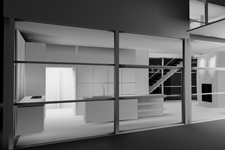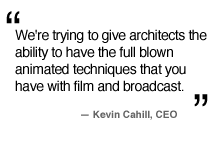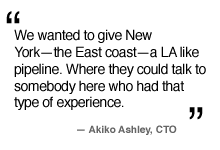- AFR
- Anthony Frausto-Robledo, Editor
- KC
- Kevin Cahill, CEO
- AA
- Akiko Ashley, CTO
- MB
- Michael Boyle, Dir. Tech.
Implementation
- DI
- David Isyomin, Visual
Effects Supervisor
- MH
- Mark Hatlan, Supervising
Animator
-

AFR
How did Luminetik get started?
AA It actually started as a collaboration between Kevin,
I and two animators in the beginning. Basically Kevin has a background
in architecture for the last twenty years and...Mark and Sean are
character animators that collaborated with Kevin on some architecture
projects. And they saw that there was much more in their architectural
skill base so they expanded.

AFR How long ago was that?
AA Three years ago.
AFR Now your background is a little different. Can you talk
about that and how you came into Luminetik?
AA I came into Luminetik when I realized that visual effects,
animation or even architectural renderings requires someone who
understands the technical side of the business.
I ran a technical consulting business both on the Macintosh and
PC side for four years. So basically I was able to bring new technology
into Luminetik and change the pipeline so we could be more cost
effective.
AFR Was your background, in terms of your consulting business,
focused on 3D firms?
AA Yes, I had quite a few of those, plus special effects
houses and ad agencies. Ad agencies also use 3D software.


AFR
Let's shift gears a bit. What types of projects launched the firm
three years ago?
AA Well, Kevin was still doing architecture
3D but he was adding, like, his little flair...like having character
animators design little characters for his architecture scenes,
and he started collaborating with the character animators and using
his visual layout skills...and combining the two skills to give
realistic looking environments.
AFR So it began with architecture. And you have done some
work for a number of architects, including the famous Maya
Lin.
AA Let's have Kevin talk about that one.
AFR So what did you do for Maya Lin?
KC The work was related to landscape
architecture and it was more for a visualization of lighting design.
I do a lot of renderings in Lightscape. In that case we actually
wound up building a physical model as well. They were more hands
on. It was the Grand Rapids Michigan Pavilion. That was about two
years ago.

She had this idea of taking the midnight sky on the millennium
and placing it in the ground, using fiber optics under the ice,
so the concept required us to find a software—which we actually
used Starry Night—to
calculate the star calculation of the sky, put that into ArchiCAD,
and then map onto working drawings so that they could actually build
it that way.
AFR Wow...
KC Which is a little unusual...(laughter). It was kind of
like using a PICT image then tracing it as a vector drawing and
turning it into a schematic design to actually construct it.
AFR How well did an architectural education prepare you
for your job as a 3D specialist?
KC Well...actually really well. When I was in school—I
went to Temple in Philadelphia—we had the first computer design
studio, which I think was in 86'.
It was supported by certain teachers and we were doing full blown
3D, animations and lighting, the whole deal.
All of the tools, the same tool set crosses over to 3D animation
easily. Animators are much looser than architecture people so you
wind up being more detail oriented or more lighting oriented than
they are...which is good because the animator people are more organic
oriented, and the combination makes a nice fit.
AFR
So you graduated from architecture school and began your career
as an architect...and then you made this big transition to 3D. What
was that transition like for you?

Continues
top right column - >
|
|
KC It's been weird because I took
a transition and did some 3D renderings and then because of these
3D renderings—which were mostly on the architectural side—I
wound up getting design projects working for architects. And then
I moved over to the 3D side again and it flip flopped.
KC Not long ago we got a project where
an architect said, "give me a 17 story high rise conceptually",
because he saw what we could do and also respected our designs....and
we came up with something without any opinion from him at all.
AFR That's pretty nice to have that
freedom.
KC It is nice, and so we were basically
taking a designers raw ideas and putting them into 3D form so they
could see them.
AFR With Lumentik, where do you want to go with architectural
3D?

KC We're trying to give architects the ability to have the
full blown animated techniques that you can have with film and broadcast.
The typical architectural walk-throughs today are typically very
low-end compared to the CG effects world. However we could bring
them up to the film level, giving them the ability to have real
interactive-animated parts of the building and people walking and
full blown effects...more than just cardboard cutouts stuck inside
a Photoshop montage—which has kind of become the standard now.
AFR Right, kind of bring these otherwise static images to
life?
KC Right. Which totally changes...when you move and see
this transition over time, or the sun changing or things like that...it
totally changes your perception of the space.
AFR What kind of tools will you be using to do that kind
of work?
KC We have a pipeline of a bunch of things. On the CAD side
we definitely use ArchiCAD,
that's are mainstay...which we use on the Macintosh. We have Lightwave
3D on the Mac as well, and we use Lightscape
on the PC, which works very well with stuff coming off the Mac.
On the dynamic animation side, what really comes in is Lightwave
and Maya. Then we end
up compositing effects together in a post situation...
AFR I see...
KC ...which is actually Final Cut now.
AFR So you have moved to Final
Cut Pro?
KC Ya, basically it's awesome!
AFR What were you using before for these compositing effects?
KC After Effects and
Premier.
KC Which are still good, I know them better than Final Cut,
but with Final Cut we just got a Matrox MT Card for the Mac...it's
what you can do for a $10,000 system for $1000 now.
AFR That's pretty amazing isn't it?
KC It's awesome! It's a breakout box, you can put it to
your DV tapes, put it on your monitor.... It's amazing what you
can do with it.
AFR Do you find that more of your architectural clients
are interested in that type of dynamic rendering?
KC We were asked about a week ago to do an on-the-Web, rotatable
island with all the buildings built on to it, so you can zoom around
the island and see this world...but the tools to do that on the
Net are just pushing the envelope right now. Just to calculate that
stuff before was insane.
That's the kind of stuff that people are starting to ask for. They
see this stuff in the films and they automatically assume you can
do that on the desktop. So we are trying to meet that need as best
as possible, but a lot of it is educating the client about time
and budget.

AFR Sure. That makes a lot of sense. Can we talk now about
non-architectural 3D. I would like to cover this area in some detail
because this is where Luminetik is really going.
KC Sure. Akiko should probably discuss much of this with
you as well.
AFR OK. Was there a particular project—beyond the architecture
3D—that really gave you the sense that Luminetik was going
to take off?
AA Well...basically I learned a couple of things working
at Luminetik. You know when we first started there was only four
of us, and with just four people there was very limited work that
we could do. But several companies were calling us like Nickelodeon,
HBO, Time-Warner, VH1...and they were asking us, you know, to work
on projects that we didn't have the personnel to do. So we realized
at that time that we either had to grow as a company so we could
take on this type of work, or we couldn't do it.
And so, as far as a business plan, it didn't make any sense not
to grow because we wanted to be in a financially better area.
AFR Sure. So what did you do?
AA So...what we did is put out an ad and started recruiting
and found some of the best animators, modelers, people in architecture,
and started interviewing them. And we went through 400 people...and
we came out with the top 10 percent.
And once we put together the teams we were also putting together
the reels and we were looking at everybody's work. And when we saw
that—this database of work—we realized that there
was a huge opportunity here in New York City. Because for a long
time advertising agencies, film companies, and broadcast people
have been going to LA, because they like the LA pipeline. They like
the way LA does the work, they like the way LA does the business.
And we wanted to give New York—the East
coast—a LA like pipeline. Where they could talk to somebody
here who had that type of experience...that type of way of
dealing with clients...and also an understanding of the technology,
the business and the market.
AFR Isn't New York a growing community of digital specialists?

|






![]()